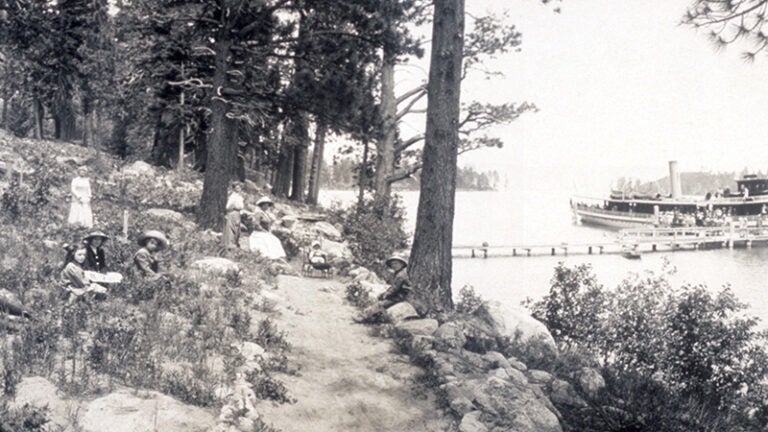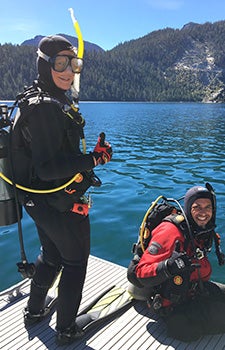
Sunken pleasure boats reveal history of California’s first vacations
The first Emerald Bay vacation camp on Lake Tahoe sprang up on the southwestern shores of the picturesque bay in 1884, some 20 years after railroads had begun to snake over mountain passes, making it possible for city dwellers to escape the hubbub of city life and find peace, solace and recreation in nature. As a result, Lake Tahoe became a mecca for wilderness lovers. Boating, fishing and hiking were all tremendous draws, and by 1907, a second Emerald Bay Resort opened at what is now the Boat-in Campground on the northern shores of the lake. This resort — which could only be reached by boat and boasted its own general store and a dancehall — thrived until after World War II. But when its fortunes declined in the 1950s, the decision was made to close it down.
To get rid of the myriad small boats that had populated the lake during the resort’s heyday, the owners decided to scuttle them.
“Sinking them in the lake was an easy way to dispose of them,” says Lynn Dodd, associate professor of the practice of religion at USC Dornsife College of Letters, Arts and Sciences. Among the collection of vessels that now lie at the bottom of the lake — the largest known group of small sunken boats in the nation — are pleasure boats, including rowboats and fishing boats, as well as larger steam launches and even barges.
Not only did the small, locally-made vessels reflect the handicraft, skill and local traditions of boat building, Dodd argues, the sunken boats of Emerald Bay are also important because they have the potential to tell the story of the emergence of vacations in our lives — a relatively new phenomenon in Western history.
Fortunately, all is not lost. An underwater Maritime Heritage Trail — the first of its kind in California — that allows divers to explore the sunken boats hidden below the waters of Emerald Bay has been created thanks to a collaboration between archaeologists and staff from the California State Parks. Now, Dodd is making it possible for USC students to help preserve the history of this area for future generations through her Fall semester course ARCG 305L, “Virtual and Digital Culture Heritage and Archaeology.”
“We want people to understand that this isn’t just a collection of little boats but a whole maritime landscape that captures life at a certain time in the history of the United States, and it hasn’t been fully documented yet,” she notes. “Our students can participate in research that’s meaningful and that gives California’s state park system new information about our cultural heritage.”
Documenting Lake Tahoe’s secrets
As part of her course, Dodd plans to offer a two-unit option: a four-day trip to Tahoe over Fall Recess. This mini field school will teach students — both divers and nondivers — the techniques of underwater photography so they can document California’s hidden heritage. Students will then learn how to transform those 2D images into high-resolution, 3D models using software. The models will be displayed at the end of the semester, then donated to the State Parks to be included in a public exhibit.
“What’s wonderful about this,” Dodd says, “is that these 3D models allow people who will never be able to dive, who can’t even swim, to experience the secret, hidden world beneath the water.”

Lynn Dodd, associate professor of the practice of religion, and USC Diving Safety Officer Eric Castillo prepare to dive at Lake Tahoe. (Photo: Kenneth Kramer.)
The week after the opening of the trail on Oct. 1, 2018, Dodd and Denise Jaffke, the State Parks’ main archaeologist and local Native American liaison, taught an international underwater photogrammetry workshop at Emerald Bay for science divers attending the annual meeting of the American Academy of Underwater Science. Then USC students at the USC Dornsife Extended Reality Lab — part of the Archaeology Research Center — processed those 2D photos into 3D models. The students presented them at a meeting of the Society for California Archaeology at the California State Capitol in Sacramento in April.
Dodd and Jaffke, along with USC Diving Safety Officer Eric Castillo, will hold a similar training workshop at the USC Wrigley Marine Science Center in June designed for students who are scientific divers, and for community members who contribute to science research projects by USC faculty.
Processing 2D photos into scaled high-resolution 3D models is a highly transferable skill, Dodd notes, with photogrammetry skills leading to jobs in the oil industry, real estate and in environmental and scientific fields.
These skills will also allow them to help document our global submerged cultural heritage, Dodd says. There are reports of 5,000 wrecks on the West Coast, she notes. Thousands of these sunken vessels have yet to be properly recorded, and put into the state’s databases.
Training provided by USC Dornsife will enable USC students to take the lead on this future effort, Dodd says.
“They can do science in the week, and on weekends, they can document submerged shipwrecks that tell the tale of the Gold Rush, of trade with China, of the ships that tell the tale of California’s emergence onto the world scene,” she said.
“People in the future are going to look back to us and to our students as the people who made this happen.”